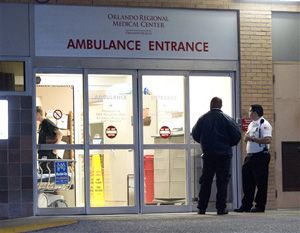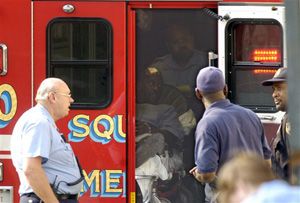At any given moment, there are prisoners inside a hospital — sometimes several. The only other public place that can claim these numbers is a courtroom. But unlike a courtroom, most hospitals lack a uniformed/armed presence, metal detectors and holding cells. When transport officers bring prisoners to a hospital, they are effectually on their own.
 Maryland State Police helicopter searches the area around a Maryland regional hospital where a prison inmate escaped during a hospital visit Jan. 2, 2008. (AP Photo/Jacquelyn Martin) |
In fact, a typical hospital is the only unprepared environment that is an integral component of the criminal justice system. Corrections officers receive scant training to prepare them for the clinical setting, which is why officers, bystanders and medical personnel are often hurt and even killed by prisoner patients (or “forensic patients”). It’s also why so many inmates escape from hospitals.
Worst-case scenarios like these underscore the importance of familiarizing yourself with the hospital environment.
The first thing to recognize is that hospitals are more of a retail environment than an industrial environment, in the sense that all sorts of people are milling around. (If you worked in a factory, you wouldn’t have strangers walking up and down the assembly line!) Hospitals are filled with sick elders and children, visitors and nuns, mothers and grandmothers, families and street gangs. Maintaining prisoner security in an environment like that is no easy trick.
If a prisoner had successful communication to the outside prior to his hospital trip, you can bet this is where he’ll try to meet up with family, friends or other gang members. In fact, hospital visits for arrestees are so routine these days that family, friends, and enemies are likely to follow you to the local hospital anyway — and often do.
Tactical awareness has to begin before you even roll-up in a hospital parking lot. With that in mind, here are seven things you can do to survive arguably the most difficult procedure involved in prisoner security.
Visit your local hospital(s)
Your agency needs to establish a pre-planned, practiced response to potential incidents in a hospital. Even if you’ve already established some sort of ad hoc routine, don’t rest on your laurels and wait for the worst to happen — instead, augment that plan. Don’t worry about being intrusive. Most hospital staff will appreciate your attention to what many already view as a problem.
Get to know the security department and talk with the director or chief of security. (This sort of access is easier in a small town, but with a little persistence, can be done anywhere.) Also, talk with the director of the emergency department, take the nickel tour and get lay of the land, including surgery, MRI, radiology, the psychiatric ward and even the maternity ward. You never know where you’re going to end up with a prisoner.
Call ahead
The first reason to call ahead is to prepare assets. If you arrive at a hospital without warning, your chances of getting the most secure room along the safest route with the least amount of public contact are shot. The less time it takes you to look for a safe place to park, get directions to a clinic, gain access to employee-only areas and ultimately get in a good room, the less time your prisoner will have to find cracks in the system and plan an escape.
 Hospital security personnel stand outside of the Emergency room at Orlando Regional Medical Center in Orlando, Fla, following a large-scale fight that sent eight male inmates to the hospital on Jan., 25, 2009. (AP Photo/Reinhold Matay) |
This also means that cohorts will also have less time to intercept you at a hospital (for which they are infamous).
Before you arrive — and I can’t stress this enough — inform both the security and emergency departments that you’re coming. Remember, in most cases you are the expert here, not the hospital staff. They will follow your lead. Make your expectations clear, and they will most likely comply.
Take the lead and clearly identify your needs:
“Hello, this is Officer Smith from the Rockland Detention Facility. I am arriving with a prisoner at approximately 5:45 p.m. He might have a broken wrist. Please have a security officer meet me with a wheelchair and a blanket outside of the ambulance bay entrance.”
Control of the transport begins with this call. If you’ve had no prior contact with the hospital, or if the ambulance bay is blocked, full, or off limits for law enforcement use, you should also ask and advise the following:
- What access can I use that’s not open to the public?
- Where’s a nearby spot I can park my vehicle?
- Is there a private room available for immediate use? I’ll need a private room as soon as possible.
- If you have an isolation room with a private bathroom available, I will need it.
One simple call ensures they’ll have things ready, your wait will be shorter and that when you arrive, you’ll have a guide who has keys and code access to virtually anywhere in the hospital. Plus, if the hospital security guard is well-trained, you’ll have some solid back-up. If he isn’t, you’ll still be better off than if you were alone, provided you direct him or her correctly.
But remember, that security officer works for the hospital, not you. He or she could be called away to other emergencies. Your prisoner’s procedures and moves, in other words, might be partially contingent on their schedule.
Predetermine access
Find the safest entry point to control ingress and access to your prisoners when casing the hospitals in your patrol area. In most cases, ambulance bays are the best points of access, even if you’re just transporting your prisoner for a minor medical clearance or psychiatric evaluation.
Public access is restricted in ambulance bays, and the route to the emergency department is predetermined. Hospitals probably would prefer you didn’t pull your squad into the ambulance bay unless it was necessary for extenuating security or medical reasons. EMTs are required to turn over ambulances quickly to make room for the next arrival. You don’t want to worry about getting back to move your car, because you don’t have the luxury of leaving your prisoner. Park as close to the ambulance bay as possible and enter on foot with your prisoner.
Wheeled and concealed-only transport
Once you’ve arrived at the door, you’ll also want to have a security officer waiting for you with a wheelchair and a blanket. Presumably, your subject is ambulatory or you would have called an ambulance to the scene; however, the purpose of the wheelchair is primarily for security. Transporting patients through hospitals in wheelchairs is not only acceptable, but frequently preferred, so it suits all parties in involved.
Place your prisoner in the wheelchair. Restrain the prisoner directly to the chair, making sure the prisoner does not have a free hand.
Make sure you have second set of cuffs or chains to secure him to the seat frame of the chair — not to a removable part of the chair. If you’re not careful, you’ll end-up dodging a loose wheelchair armrest. Use leg shackles to impede movement as well. Remember, your prisoner will be in direct contact with the public and you are responsible for everyon’s safety, not the hospital.
There are other methods for restraining a patient in a wheel chair that involve the use of a back strap, chains, etc. Either way, the idea is to add another level of security. If your prisoner wants to run out the door and down the street, he’ll have to do it chained to a wheelchair or gurney.
Once the prisoner is in the chair, cover him with the blanket to conceal the restraints. This is a win-win practice. When the public and curious children aren’t drawn to the sight of a handcuffed and shackled prisoner, you win; and when hospital staff members don’t see them in the open, you win.
I’ve heard all sides of the argument regarding this suggestion. I’ve heard officers say there is a benefit to the public humiliation caused by being seen in police restraints. They also argue that they like to see where even a cuffed prisoner’s hands are. I’ve also seen doctors and hospital administrators become infuriated by the sight of handcuffs and shackles. And make no mistake, some doctors and nurses automatically make it their business to say and do anything they can to get you to take them off.
I’ve also seen patients and visitors who were frightened by the sight of shackled prisoners in public hallways and waiting areas. Refusing to practice reasonable discretion with regard to restrained forensic patients in plain view is indefensible in the eyes of the pubic and hospital personnel. Your goal should also be to keep your prisoner calm and controlled, so it’s also tactically smart.
Minimizing a prisoner’s embarrassment, thereby maintaining his dignity, is tactically smart. It will go a long way to helping you remain in control. If you’ve done a thorough search and keep your eyes on him at all times, covering the inmate’s restraints shouldn’t pose a problem.
Remember, when moving the prisoner through the facility, you should be the one pushing the wheelchair, not the security officer or medical staff. This puts you in the best possible control position should your subject attempt anything. Ask the security officer to walk ahead of you. His job will be to get you through coded and locked doors and to keep bystanders away. The security officer will also be in a good cover position should things go south.
If you’ve transported your subject by ambulance, then you need to secure them to the gurney. Use shackles to stabilize their feet, and attach those to the gurney. You may have to use a strap or extra set of cuffs to get this accomplished.
 A wounded prisoner lays in an ambulance outside a Md. hospital after as many as 15 people were stabbed during a fight June 1, 2007, at the Metropolitan Transition Center correctional facility in Baltimore. (AP Photo/Steve Ruark) |
Forensic patients have seriously inured and killed officers by kicking them from gurneys. Assist in moving the gurney from the front, and have the security officer walk a few feet ahead.
Maintain custody
Recently, there were four escape attempts from one public hospital in a single week. One attempt was successful; one required the partial evacuation of the emergency department for most of an hour; one ended with an injury to a nurse; and another almost ended a corrections officer’s career.
Three of the four escapees were completely unrestrained (none for a bona fide medical reason). Two were unnecessarily unrestrained for a routine examination. One was left in loosely applied leg shackles, which he slipped out of as soon as the CO took him to a bathroom break. Two of the four escape attempts were connected to unsupervised toileting. All were the result of presumed compliance and careless practices.
None of these escapes attempts made headlines for a few key reasons: They weren’t successful, the CO wasn’t fired, and no one was seriously injured or killed. But a more telling reason they weren’t newsworthy is because escape attempts are becoming routine in hospital ERs. Most of these escapes fail, though usually not without significant embarrassment or injury to corrections and police officers.
Beware presumed compliance
Don’t let presumed compliance be your downfall in a clinical environment. Nurses and doctors have assured me that people can convincingly fake just about anything enough to fool many first responders in the field — even heart conditions. So, if a nurse, doctor, X-ray technician or other allied health professional asks you to remove restraints, you need to ask why.
(Even if a medical professional makes the decision to remove the restraints, you could still end up with the lion’s share of the liability, should someone get hurt. Law enforcement restraints are administrative restraints intended to maintain legal custody, as opposed to hospital restraints, which are behavior stabilization equipment.)
When asked to remove restraints, ask first if there is an alternative to removing them. If they reply that there is none, advise them that the reason for removing the restraints has to be documented in your report, so you’ll need their name, the reason why the prisoner had to be unrestrained, and why there was no alternative. Then request that they document those reasons in the patient’s chart.
Alternatives tend to magically appear when people are asked to share in any possible consequences for second-guessing a correctional or police officer.
Sometimes handcuffs, belly chains and shackles really do have to come off, e.g., for MRI imaging procedures, X-rays at the restraint site or other procedures that may genuinely be incompatible with standard police restraints. Since you can’t just take them off and hope for the best, you’ll have to find an alternative.
Hospitals with professional security and/or psychiatric custodial staff have special training and equipment to use for restraining patients. If you’re working alone, ask for a security officer to assist you during the procedure. Station yourself between the door and the patient. If it’s an X-ray procedure, put on a lead apron, ask where it’s safe to stand, and place the security officer in a cover position outside the door. Keep your eyes on your prisoner at all times.
If you’re in a clinic or hospital without dedicated security and/or behavioral restraint equipment, you’ll need to request another officer from your own department to assist you. Managing unrestrained prisoners in a public clinical environment is inherently dangerous. Managing them alone is just plain reckless.
Forensic isolation
The concept of “forensic isolation” is something healthcare providers can understand and appreciate. Law enforcement officers can get behind it, too. If there’s one point of common ground, this is it.
If law enforcement officers had their way, there would be a sally port next to every ambulance bay and a row of cells in every emergency room. But that’s not very realistic. Some hospitals do have forensic rooms for prisoner patients, and that’s a good thing. Others hospitals with dedicated psychiatric patient care may have emergency seclusion facilities (but even this is a pretty progressive idea). Most of them are glorified broom closets with restraint beds and padded walls that are not dedicated to emergency medical care. On the whole, hospitals tend to resist the extra costs associated with forensic emergency medical facilities.
I have been involved in conversations about this subject between law enforcement officials and hospital administrators, and in both cases they reached they reached the same impasse: The hospital feels that it is required to treat society’s prisoners, and it’s the responsibility of police agencies and corrections departments to keep everyone else safe while forensic patients are in their midst – the upshot is that if county, state or federal funds will foot the bill, hospitals will build all the forensic facilities corrections and police officers want.
A conversation about budgeting for secure facilities inside private hospitals is a conversation worth having.
 Brandon T. Morris, 21, is led in handcuffs from a Md. county courthouse, June 1. 2007. Morris was on trial for killing a correctional officer while escaping a hospital (AP Photo/Timothy Jacobsen). |
Inside many hospital emergency rooms are isolation rooms designed to contain infection. A true isolation room has a negative pressure system to prevent contaminated air from being released into the general patient population. Good ones also have a separate entrance, like an air lock, so care providers and visitors can wash and “gown up” without contaminating the common areas outside the room.
(Cadillac emergency department isolation rooms even have a private bathroom. Typical emergency examination and procedure rooms have shared bathrooms for patients located in the common area.)
Violence in healthcare settings is on the rise. So if there’s one concept law enforcement officers need healthcare providers to accept, it’s that their job is inherently dangerous.
Healthcare providers are four or five times more likely than “traditional” workers in to be a victim of workplace. The risk rises precipitously for workers in emergency medicine, behavioral health or critical care; staff here is vulnerable to assault by a patient or family member.
Healthcare providers are drilled with infection control principles, but it’s looking more and more like they’re at greater risk for serious injury or death from violence than from an errant needle stick. It’s time to start treating violence as a healthcare issue not just for patients, but for providers.
Given the absence of forensic isolation rooms, what can we do to isolate patient prisoners? Obviously, we want them out of public contact ASAP. Just like a kid with chicken pox gets bumped to the front of the line in a waiting room full of kids with tummy aches and rashes, forensic patients and patients otherwise at risk for violence, need to be given triage priority.
Ask that emergency staff get your prisoner to a room as soon as possible. Explain that it’s for their safety. They don’t need to know anymore than that, and it will certainly get their attention.
Use your tactical communications and a good Tactical 8-Step®:
- Hello.
- I’m Officer Smith with the Rockland Detention Facility.
- I’m bringing this prisoner to be medically cleared for the jail.
- He is complaining about pain in his side.
- I need to keep him out of the waiting area.
- For everyone’s safety, I need to secure him on a gurney inside the room, preferably, an isolation room.
- We’ll wait off to the side here until you can get us into the next room.
- Thank you.
The typical emergency department exam room is the last place you’d want to get into a fight. Equipment is sticking out from the walls everywhere; the room is filled with glass, sharp objects, bio-hazards, poisons, needles, flammable liquids and all sorts of weapons of opportunity, from wheelchairs and IV pole parts that make great improvised weapons.
The real power that corrections officers have in these situations is to lead with authority in the institutional setting by making your expectations reasonable, legal, and most of all, clear. If you emphasize the importance of these safety procedures, it will give them credibility in their eyes.
Supervised toileting
Here we go. The one subject no one wants to deal with, talk about or even think about. But we have to think about it, because toileting is the point at which many of these escapes occur.
In the prisoners mind, here’s how it should play out:
- Fake the right symptoms
- Get inside a hospital ER
- Tell them I have to defecate to get privacy and get un-cuffed.
- Escape
Now that we’ve said it out loud, there should be no question. Just like IAMO, remove one of these things — intent, ability, motive, or opportunity — and no escape can be attempted.
The only way your prisoner can escape is if they fool you into helping them. They need your cooperation. It’s up to you if you want to give it to them. A prisoner in restraint loses their right to privacy when safety is at issue. If that weren’t the case then jail cells would have hospital curtains. Do your part to end rampant prisoner escapes, and stop sending prisoners unsupervised and unrestrained into a public bathroom.
Some doctors have tried to deny bathroom use to forensic patients as a way of dealing with the problem, but this can land you, the doctor, and the hospital into court; especially, if the prisoner is forced to soil himself, so don’t get caught up in that trick bag. If your prisoner needs to use the bathroom, you have a few good options, none of which include unrestraining the prisoner or leavin Patients are assigned to isolation rooms for chicken pox, tuberculosis, measles and other highly contagious diseases. g him alone.
If the patient needs to urinate, leave them in restraints and ask for nursing assistance. Determine the risk to the nursing staff. If acceptable, ask them to attempt using a urinal with the patient, while they are restrained to the gurney. Keep eyes on at all times, so the nursing staff doesn’t make tactical errors like exposing themselves to possible head butts, bites, grabs or kicks.
If the patient needs to have a bowel movement, secure him in a handicapped equipped patient bathroom. Secure one hand to the safety bar mounted next to the toilet.
If there is no safety bar, then use the pipes under the sink or anything that might serve as a hard-point. No hard-point? Then cuff them directly to a belly chain. Also, make sure your prisoner is in leg shackles.
Allow him one hand free if you must, but if you have belly chains, secure the other hand to the chain with two sets of cuffs. That way your prisoner has the mobility to clean himself and still remain somewhat secure.
Glove up so you can escort him to the sink and wash afterwards. The door stays open or you go inside. Privacy provides opportunity and the insistence on privacy demonstrates intent.
Don’t help your prisoner escape by being fooled into giving him exactly what he wants. Yes it’s gross, unglamorous, and a drag to do business this way, but it’s the only safe and legal way to do it, outside of building a jail cell inside every hospital emergency room in America.
If you take anything away from this article, take away these points:
- Never leave your prisoner conscious, unrestrained and alone all at the same time.
- If they have to be unrestrained, have them outnumbered.
- Isolate them from the public as much as humanly possible.
- Custody guarantees no privacy.
Surgical and diagnostic procedures may require you to adapt to the clinical environment, but they will never require you to sacrifice every security measure. If you go to the hospital prepared and understanding that it really is the weakest link in prisoner custody, then it’s highly unlikely anyone will ever escape from your care and custody.

